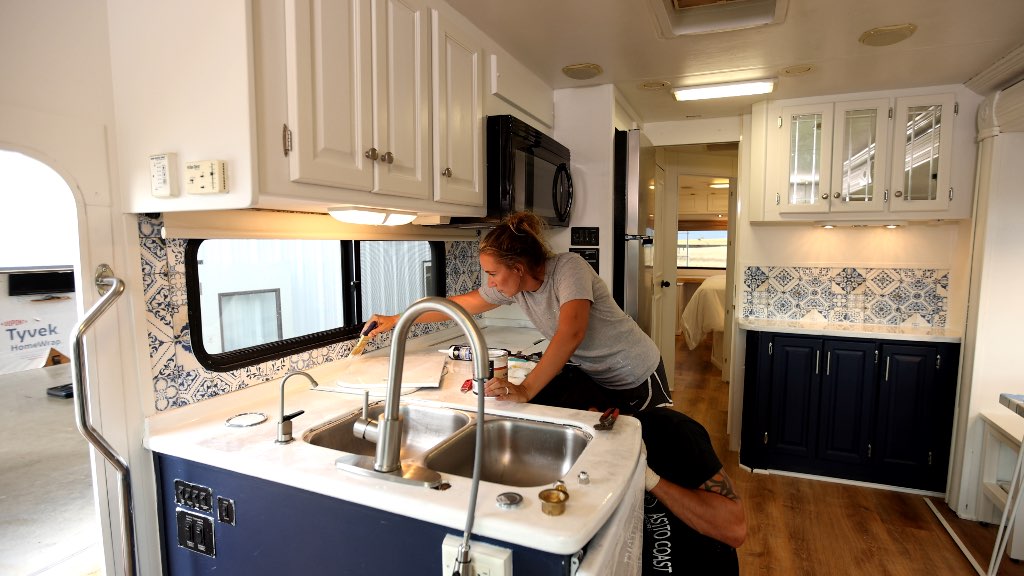Tech Q&A – June 2023
Fifth-Wheel Tire Replacement, Taillight Circuit Short, and Water Pump Blows Fuses
Image Caption:
Replacing Fifth-Wheel Tires
Q: I currently own a Vanleigh 365RL fifth-wheel that has Westlake CR960A load-range G tires that are five years old. I want to replace them with another G-rated, top-rated brand. I considered the Goodyear Endurance all-season tire of the same size (ST235/85R16), but it seems they only have an E-rated tire of this size. I have had previous tire problems with an older fifth-wheel that I don’t have anymore, and I don’t want to have that problem anymore.
I weighed my truck and fifth-wheel. The truck and trailer weighed 22,740 pounds, and the trailer only connected with the truck off the scale weighed 11,220 pounds. What are your recommendations for a top-rated brand, preferably an American brand? Thank you for any help you can give me. I especially like your column in RV Magazine.
—Michael Redman, Espanola, New Mexico
A: Most tire manufacturers recommend tire replacement due to age at about six years. I believe that most trailer tire failures are due to:
- Aged and weathered rubber.
- Under-inflated tires due to neglect or a leak from a puncture that goes undetected until overheating and a blowout occur.
- Poor-quality tires. Goodyear Endurance tires have a good reputation. Goodyear Endurance E-rated size ST235/85R16 has a maximum load rating of 3,640 pounds, while the current ones on your Vanleigh fifth-wheel have a 4,400-pound maximum rating.
However, your trailer weight of 11,220, divided by four, equals only 2,805 pounds per tire. That should leave plenty of safety margin at 835 pounds per tire, which adds up to 3,340 pounds for a set of four. Just make sure they are inflated for the weight they are carrying according to the Goodyear load inflation table.
Short in the Trailer Taillight Circuit?
Q: We have a 2021 Ford F-350 Lariat pickup and use it to tow a 2018 Grand Design Reflection 337RLS trailer. There is an intermittent short that takes out the 30-amp fuse that runs the tail-/running lights. I have gone through all I know about checking for a wire that touches a ground but haven’t found anything so far.
The last time I had the trailer out, I towed it about 260 miles before it shorted and blew the fuse. That was with the trailer plugged into the connector in the bed. On the return, it was plugged into the bumper connector; this time I barely made it out of the campground before it blew. Is that telling me something?
—Lee Phillips, Weston, Vermont
A: The fact that the fuse blew sooner while using the rear trailer connector may be a coincidence or not. First, I’d check the female connector at the back of the truck carefully, looking for loose wires or connectors in and around that area. But the fact that it blew the fuse when connected to either plug-in connector leads me to suspect it’s a problem with the trailer. Typically trailer wiring problems are at either end, near the plug or near the light fixtures.
I would start by wiggling and twisting the wires around the trailer tongue area. Next, climb underneath and follow the wiring to the taillights and clearance marker lamps. Look for places where the insulation may have been chewed by rodents or rubbed against metal, such as suspension moving parts or frame cross members, etc.
You may find a wire-tracing tool helpful. You can buy them online for less than $30. If necessary, you could install separate fuses rated for five or 10 amps on the trailer taillight circuit where the wire branches out to power taillights and side-marker and clearance lights. Then a short would take out one smaller fuse, not all the lights, and let you know which part of the circuit has the intermittent short.
Summer RV Storage
Q: We are planning to leave our trailer in Wellton, Arizona (not in use from May to late December). We would love to hear your suggestions on how best to protect our winter home from the long, hot summer months. Do you have a list of things to do, such as for winter care for living up north?
—Carol Krahenbuhl, Worley, Idaho
A: Wellton has an average summer peak temperature of 106 degrees, and it’s a dry heat! An article on this very subject is on the RV.com website.
Be sure to close off entry points for rodents and insects. This includes water heaters, furnaces, refrigerators, power-cord entry covers, etc. Batteries can be kept alive with solar chargers. An RV cover helps protect the finish from the damaging effects of the sun and be sure to keep roof vents and some windows cracked open to accommodate air circulation.
Lightweight Generator
Q: We have a small Keystone 1800RB travel trailer and do mostly dry camping. I have installed a 100-watt solar panel and a 2,000-watt inverter and upgraded to two six-volt, deep-cycle batteries. This is sufficient for running most of the appliances, but I still need to power the 13,500-Btu air conditioner. I was told the minimum-wattage generator needed would be 3,000 watts.
The trailer has no room for a permanently mounted generator, so I need a lightweight unit. Are there any 3,000-watt generators that weigh less than 60 pounds? I know there are some 2,300-watt generators that meet the desired weight, but I don’t think they would operate the air conditioner.
I have to carry and move it from the back of my SUV, so size and weight are critical. I am sure others with small trailers would also benefit from a small, lightweight generator. The Honda generator is a possibility but is very expensive. The 3,500-watt Champion is priced competitively but is too large and too heavy for me.
—Lee Sheldon, Lincoln, California
A: The problem with powering air conditioners with a generator is the initial starting current, which is way more than the running current. This can overload the genset and pop the circuit protection. One way to get around that is to install a SoftStart kit, which substantially reduces the starting current requirement of the air conditioner and its motor.
With that installed, you should be able to use a lighter and compact inverter-type 2,300-watt surge-rated generator with a continuous rating of about 2,000 watts.
Solar Add-On Advice
Q: Regarding “Solar Add-On” in January’s Tech Q&A column, you left off one key element related to the Zamp solar plug on the side of the trailer: It’s reverse-wired from the industry standard. People buying other brands of solar panels, including solar suitcases, need to be aware they need to buy a readily available polarity reversal adapter. It’s easy enough to peek under the trailer and see what the wiring colors are.
Also, most solar suitcase systems have a built-in charge controller, so no separate controller is needed if you go that route.
—Bill DiGuiseppi, via email
A: Thanks for sharing your tips! We are receiving a lot of questions from our readers about solar installations, and this is sure to help some folks.
The Zamp plug receptacle may be miswired on your RV, but that’s not how it is across the board with all RVs. I’ve used two different portable solar panel kits on different RVs with Zamp plugs and didn’t have any problems with solar charging.
Miswired components happen on RVs of all types, so it’s not a bad thing to check before plugging in the first time—but it is definitely not required to buy a polarity reverser.
Battery Drain Problem—Comment
The “Battery Drain Problem” letter in the February issue is very complete and comprehensive, but the possibility of installing an “auto-start” system for the generator was not mentioned. My Newmar Ventana 4037, and many other Class A motorhomes, have such a feature. It has a Magnum inverter and an eight-battery array with a three-door residential fridge.
When not on shorepower, depending on what time we turn in for the night, our generator will auto-start at least once during the night. The generator control panel is also Magnum, so I am pretty sure they have any hardware-electronics-software to provide Mr. McCormick with this solution, which should be significantly less expensive and more effective than changing out the fridge, or any other solution.
—Kent Wyman, North Kingstown, Rhode Island
Thanks for writing, Kent. For our readers who may be interested in adding this feature, click here to find out more about the Magnum autostart.
Water Pump Blows Fuses
Q: I own a 2013 Dutchmen Denali 293RKS fifth-wheel and this past fall encountered a water-pump problem. I replaced the originally equipped water pump, which was a SHURflo 3.5-GPM, 45-psi, 12-volt DC, with 16-gauge connection wires. The replacement is a SEAFLO 55-Series pump, which flows at 5.5 GPM and features 60 psi with 14-gauge connection wires. My hope was to replace the original water pump with a bigger and stronger pump capable of more pressure.
The removal of the old pump and the installation of the new pump were not too difficult. The problem I encountered was when I turned the pump on, it would run for a moment and then blow the fuse. It was blowing the 10-amp fuse in the power box. It went through two fuses before I replaced it with a 15-amp fuse as I was trying to winterize my trailer. I don’t want to have to buy a smaller pump, but can you help me figure out the problem and how to fix it permanently?
—James Jaramillo, Hooper, Utah
A: You need 14-gauge wire or heavier to handle a 15-amp draw, James. So just make sure that the wire from the fuse box is 14 gauge all the way, and not just some 16 gauge connecting to the 14 gauge. Also, you need to be sure to run a heavier (14) gauge ground wire all the way to a good ground connection.
Another Lithium Question
Q: We have a 2007 Winnebago Voyage Class A motorhome on a Workhorse chassis with the GM 8.1-liter Vortec V-8 gas engine. I have replaced the alternator once with an OEM unit. It has the original MagneTek 7445 45-amp converter. I am considering changing from the two lead-acid house batteries to two 100-amp lithium batteries with built-in battery management systems.
We live in Florida, so cold is rarely an issue. We just want a little extra power for an occasional overnight and less maintenance. I am looking at putting in the batteries and changing the converter because the current setup will only put out about 13.8 volts.
Two additional questions: 1. Is changing the converter a good idea, or absolutely necessary? 2. Because the house batteries also charge from the engine alternator, do I need to make any changes there?
—Don Miller, Leesburg, Florida
A: According to the information I have, the converter in your motorhome is not designed to charge lithium batteries, so you’ll need to upgrade. I suggest switching to an inverter/converter.
The alternator’s voltage regulator is set to charge conventional batteries; the voltage doesn’t go high enough to fully charge LiFePO4 batteries. However, because lithium batteries have low internal resistance, they can overload the alternator during charging and may overheat and damage the alternator as a result. Therefore, you should install a battery-to-battery controller to limit the charging current from the alternator to the lithium batteries.
Tires During Storage Follow-Up
Q: I have a 2015 Mobile Suites RSSB3 fifth-wheel. Reading the “Tires During Storage” letter in the January issue brings a couple of questions to mind. I travel with my work and am normally at a work location for a couple of months, then move to the next location. So, I have not been really concerned about the weight of the fifth-wheel resting on the tires.
I do cover the tires most of the time and, depending upon the surface the tires are resting on, I have two long 2-by-12s with plastic cutting boards attached for the tires to rest on. I will be located for an extended period of time at one location, probably 12–14 months. The letter raised a question Should I get the weight of the fifth-wheel off the tires during this extended period?
There are four hydraulic levelers located front and back of each tire. Should I use these to lift the fifth-wheel and take the weight off the tires? Doing this seems like it would stress the springs and the air-ride system. What would be the best way to take the weight o the tires and not compromise the suspension but still have a stable foundation for the fifth-wheel to rest? I will also cover the tires for this stay.
—Bill Turner, Livingston, Texas
A: Most leveling jacks are designed for leveling, not supporting the entire weight of the RV. I suggest lifting the trailer with a sufficiently rated hydraulic bottle jack, which you probably already have for changing trailer tires.
Be certain to lift at strong points on the chassis, such as around axle spring mounts. Support the frame at these strong points with jackstands rated for the appropriate weight, centered on large, flat paving blocks set into the soil or with heavy wooden blocks. Of course, be sure to keep it level.
Master Cylinder
Q: I have a 1996 Gulfstream Conquest 32-foot Class C motorhome on a Ford E-350 chassis with a Power Stroke Diesel engine. It has a problem with its brakes, so I took it to a truck repair shop, and they said they couldn’t fix it.
The motorhome has a tag axle and a master cylinder with a vacuum booster that goes to the tag axle. The truck shop sent this part to a place in Florida that rebuilds them, but it was rusted out, and they couldn’t rebuild it. I am hoping you might know a place where I can buy a replacement part, either new or used.
—Carl F. Adkins, Prichard, West Virginia
A: When the cylinder bore has rust pitting in it, it must be bored out and re-sleeved with a stainless-steel insert. There’s an excellent company called White Post Restorations in Virginia that repairs master cylinders that way. Let me know how it works out.
Reader Tip: Winterizing
We have been trailering since 1970 and have trailered in 49 states. We have owned three travel trailers and eight fifth-wheels. We currently have our fifth Montana, a beautiful 371⁄2-foot loaded fifth-wheel that we tow with a three-quarter-ton Chevy Duramax.
I have been doing my own winterizing on all the trailers, and by experimenting, I discovered that if I hold the jug of anti-freeze up even with or higher than the pump, it will draw just fine. My wife then runs each faucet until it comes out pink. Don’t forget the toilet, shower, and outside faucet.
—Billy Hilton, Rapid City, South Dakota
Have a Question?
Looking for answers on all things RV, including systems, engines, accessories, or construction? Submit it to our expert at [email protected], and it may be selected for publication. You must include your name, city and state, phone number (will not be published), and type and model of your RV.





